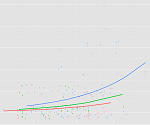Stata allows you to describe, graph, manipulate and analyze your data in countless ways. But at times (many times) it can be very frustrating trying to create even the simplest results. Join us and learn how to reduce your future frustrations.
This one hour demonstration is for new and intermediate users of Stata. If you’re a beginner, the drop down commands can be extremely daunting.
If you’re an intermediate user and not constantly using Stata, it’s impossible to remember which commands generate the results you are looking to create.
 This webinar, by guest presenter Jeff Meyer, will give you five actionable tips (and examples you can re-use) that will make your next analysis in Stata much simpler.
This webinar, by guest presenter Jeff Meyer, will give you five actionable tips (and examples you can re-use) that will make your next analysis in Stata much simpler.
We’ll explore:
- Save time with a do-file to create the table you want exactly as you want.
- A few methods (some easier than others) to create dummy variables out of a categorical variable with several categories
- At least three ways to insert a table into a document
- Quickly alter the looks of your graphs through the use of macros
- How to aggregate data to the group level based on a number of parameters
Date: Wednesday, July 29, 2015
Time: 4pm EDT (New York time)
Cost: Free
***Note: This webinar has already taken place. Sign up below to get access to the video recording of the webinar.
Our next free webinar is titled: “Random Intercept and Random Slope Models” and is coming up in August
Jeff Meyer is a statistical consultant with The Analysis Factor, a stats mentor for Statistically Speaking membership, and a workshop instructor. Read more about Jeff here.
Why does ANOVA give main effects in the presence of interactions, but Regression gives marginal effects?
What are the advantages and disadvantages of dummy coding and effect coding? When does it make sense to use one or the other?
How does each one work, really?
In this webinar, we’re going to go step-by-step through a few examples of how dummy and effect coding each tell you different information about the effects of categorical variables, and therefore which one you want in each situation.
Note: This training is an exclusive benefit to members of the Statistically Speaking Membership Program and part of the Stat’s Amore Trainings Series. Each Stat’s Amore Training is approximately 90 minutes long.
About the Instructor

Karen Grace-Martin helps statistics practitioners gain an intuitive understanding of how statistics is applied to real data in research studies.
She has guided and trained researchers through their statistical analysis for over 15 years as a statistical consultant at Cornell University and through The Analysis Factor. She has master’s degrees in both applied statistics and social psychology and is an expert in SPSS and SAS.
Not a Member Yet?
It’s never too early to set yourself up for successful analysis with support and training from expert statisticians.
Just head over and sign up for Statistically Speaking.
You'll get access to this training webinar, 130+ other stats trainings, a pathway to work through the trainings that you need — plus the expert guidance you need to build statistical skill with live Q&A sessions and an ask-a-mentor forum.
One great thing about logistic regression, at least for those of us who are trying to learn how to use it, is that the predictor variables work exactly the same way as they do in linear regression.
Dummy coding, interactions, quadratic terms–they all work the same way.
Dummy Coding
In pretty much every regression procedure in every stat software, the default way to code categorical variables is with dummy coding.
All dummy coding means is recoding the original categorical variable into a set of binary variables that have values of one and zero. You may find it helpful to (more…)
Every statistical software procedure that dummy codes predictor variables uses a default for choosing the reference category.
This default is usually the category that comes first or last alphabetically.
That may or may not be the best category to use, but fortunately you’re not stuck with the defaults.
So if you do choose, which one should you choose? (more…)
Need to dummy code in a Cox regression model?
Interpret interactions in a logistic regression?
Add a quadratic term to a multilevel model?
 This is where statistical analysis starts to feel really hard. You’re combining two difficult issues into one.
This is where statistical analysis starts to feel really hard. You’re combining two difficult issues into one.
You’re dealing with both a complicated modeling technique at Stage 3 (survival analysis, logistic regression, multilevel modeling) and tricky effects in the model (dummy coding, interactions, and quadratic terms).
The only way to figure it all out in a situation like that is to break it down into parts. (more…)
In my last blog post, I wrote about a mistake I once made when I didn’t realize the defaults for dummy coding were different in two SPSS procedures (Binary Logistic and GEE).
Ironically, about the same time I wrote it, I was having a conversation with Ann Maria de Mars on Twitter. She was trying to figure out why her logistic regression model fit results were identical in SAS Proc Logistic and SPSS Binary Logistic, but the coefficients in SAS were half those of SPSS.
It was ironic because I, of course, didn’t recognize it as the same issue and wasn’t much help.
But Ann Maria investigated and discovered that it came down to differences in the defaults for coding categorical predictors in SAS and SPSS that did it. Her detailed and humorous explanation is here.
Some takeaways for you, the researcher and data analyst:
1. Give yourself a break if you hit a snag. Even very experienced data analysts, statisticians who understand what they’re doing, get stumped sometimes. Don’t ever think that performing data analysis is an IQ test. You’re bringing together many skills and complex tools.
2. Learn thy software. In my last post, I phrased it “Know thy software”, but this is where you get to know it. Snags are good opportunities to investigate the details of your software, just like Ann Maria did. If you can think of it as a challenge to figure out–a puzzle–it can actually be fun.
Make friends with your syntax manuals.
3. Get help when you need it. Statistical software packages *are* complex tools. You don’t have to know everything to use them
Ask colleagues. Call customer support. Call a stat consultant. That’s what they’re there for.
4. A great way to check your work is to run your test two different ways. It’s another reason to be able to use at least two stat software packages. I’m not suggesting you have to run every analysis twice. But when a result looks strange, or you want to double-check a specific important model, this can be a good strategy for testing things out.
It may be that your results aren’t telling you what you think they are.
[Logistic_Regression_Workshop]
 This webinar, by guest presenter Jeff Meyer, will give you five actionable tips (and examples you can re-use) that will make your next analysis in Stata much simpler.
This webinar, by guest presenter Jeff Meyer, will give you five actionable tips (and examples you can re-use) that will make your next analysis in Stata much simpler.



 This is where statistical analysis starts to feel really hard. You’re combining two difficult issues into one.
This is where statistical analysis starts to feel really hard. You’re combining two difficult issues into one.